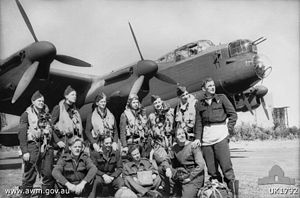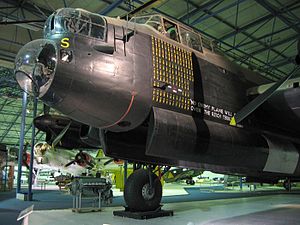- No. 467 Squadron RAAF
-
No. 467 Squadron RAAF 
Aircrew and ground staff from No. 467 Squadron RAAF with one of the Squadron's Lancaster bombers in August 1944. The Lancaster is K Kitty. Standing second from the right is navigator, Robert Sillett from Australia.Active 7 November 1942 – 30 September 1945 Country  Australia
AustraliaAllegiance  United Kingdom
United KingdomBranch  Royal Australian Air Force
Royal Australian Air ForceRole Bomber squadron Part of No. 5 Group RAF, Bomber Command[1] Motto Latin: Recidite Adversarius Atque Ferociter[2]
(Loosely translated as: "Your opponents will retreat because of your couragious attack")Battle honours
- Fortress Europe, 1940–1944
- France and Germany, 1944–1945
- Ruhr, 1940–1945
- Berlin, 1940–1945
- German Ports, 1940–1945
- Normandy, 1944
- Walcheren
- Rhine
Commanders Notable
commandersJohn Balmer (1943–44)[3]
William Brill (1944)[3]Insignia Squadron badge A Kookaburra with a snake in its beak (unofficial)[2] Squadron code PO (November 1942 – September 1945)[4][5] Aircraft flown Bomber Avro Lancaster No. 467 Squadron RAAF was a Royal Australian Air Force bomber squadron during World War II, active in the European Theater of Operations as an Article XV Squadron under command of the Royal Air Force.
Contents
History
No. 467 squadron was formed at RAF Scampton, Lincolnshire in the United Kingdom, under the Empire Air Training Scheme on 7 November 1942 and was equipped with Avro Lancaster heavy bombers. Soon after becoming operational the squadron moved to RAF Bottesford, Leicestershire, where it remained for a year before moving back to Lincolnshire, at RAF Waddington, where it was based for the rest of World War II. The Squadron formed part of No. 5 Group, RAF Bomber Command and conducted raids on Germany, France and Italy from 1943 until 1945. During these raids the Squadron gained a reputation for accurate bombing and was selected to attack the Dortmund-Ems Canal on a number of occasions.
 Avro Lancaster R5868 in the Bomber Hall of the RAF Museum London
Avro Lancaster R5868 in the Bomber Hall of the RAF Museum London
Following the end of the war in Europe No. 467 Squadron moved to RAF Metheringham and was selected to form part of Tiger Force and operate against Japan from bases in Okinawa. However, the war ended before the Squadron deployed to Asia and it was disbanded in the United Kingdom at Metheringham on 30 September 1945.
467 Squadron was the 'owner' of several famous Lancasters, amongst them LL843, survivor of 118 missions, and R5868, "S" for Sugar, which flew 137 operational sorties, more than any other RAF Bomber, except ED888[6]. After the war this aircraft was selected to be preserved and could be seen for a number of years at the entrance of the first base of 467 squadron, RAF Scampton. It now resides at the Royal Air Force Museum at the site of the former Royal Air Force station RAF Hendon, Colindale, London.[7]
Aircraft operated
Aircraft operated by no. 467 Squadron RAAF, data from[6][8][9] From To Aircraft Version November 1942 September 1945 Avro Lancaster Mks.I, III Squadron bases
Bases and airfields used by no. 467 Squadron RAAF, data from[6][8][9][10] From To Base 7 November 1942 24 November 1942 RAF Scampton, Lincolnshire 24 November 1942 12 November 1943 RAF Bottesford, Leicestershire 12 November 1943 16 June 1945 RAF Waddington, Lincolnshire 16 June 1945 30 September 1945 RAF Metheringham, Lincolnshire Commanding officers
Officers commanding no. 467 Squadron RAAF, data from[11] From To Name 7 November 1942 15 August 1943 (KIA) Wing Commander C.L. Gomm, DSO, DFC 18 August 1943 11 May 1944 (KIA) Wing Commander J.R. Balmer, OBE, DFC 12 May 1944 8 February 1945 Wing Commander W.L. Brill, DSO, DFC & Bar 8 February 1945 8 February 1945 (KIA) Wing Commander J.K. Douglas, DFC, AFC 9 February 1945 4 March 1945 (KIA) Wing Commander E. Le Page Langlois, DFC 4 March 1945 30 September 1945 Wing Commander I.A.H. Hay See also
- List of surviving Avro Lancasters
- Keith Thiele
References
- Notes
- ^ Delve 1994, pp. 62, 69, 77.
- ^ a b www.467463raafsquadrons.com
- ^ a b RAAF Historical Section 1995, p. 147.
- ^ Bowyer and Rawlings 1979, p. 83.
- ^ Flintham and Thomas 2003, p. 97.
- ^ a b c Moyes 1976, p. 260.
- ^ Franks 1994, p. 29.
- ^ a b Halley 1988, p. 484.
- ^ a b Jefford 2001, p. 95.
- ^ Jefford 2001, pp. 208–209.
- ^ Australian War Memorial: 467 Squadron
- Bibliography
- Blundell, Harold M. They flew from Waddington! 463–467 Lancaster Squadrons, Royal Australian Air Force. Sydney, Australia: W. Homer, 1975.
- Bowyer, Michael J.F. and John D.R. Rawlings. Squadron Codes, 1937–56. Cambridge, UK: Patrick Stephens Ltd., 1979. ISBN 0-85059-364-6.
- Delve, Ken. The Source Book of the RAF. Shrewsbury, Shropshire, UK: Airlife Publishing, 1994. ISBN 1-85310-451-5.
- Easton, Arnold DFC. We Flew Old Fred – The Fox, Lancaster PO-F (DV372), the Operational Record of Forty-Nine Bombing Raids During World War II. Newstead, Victoria, Australia: Hudson Publishing, 1997. ISBN 0-94987-364-0.
- Eather, Steve. Flying Squadrons of the Australian Defence Force. Weston Creek, ACT, Australia: Aerospace Publications, 1995, p. 127–128. ISBN 1-875671-15-3.
- Flintham, Vic and Andrew Thomas. Combat Codes: A full explanation and listing of British, Commonwealth and Allied air force unit codes since 1938. Shrewsbury, Shropshire, UK: Airlife Publishing Ltd., 2003. ISBN 1-84037-281-8.
- Franks, Norman. Claims to Fame: The Lancaster. London: Arms and Armour Press, 1994. ISBN 1-85409-220-0.
- Halley, James J. The Squadrons of the Royal Air Force & Commonwealth, 1918–1988. Tonbridge, Kent, UK: Air-Britain(Historians) Ltd., 1988, p. 484. ISBN 0-85130-164-9.
- Jefford, C.G. RAF Squadrons, a Comprehensive record of the Movement and Equipment of all RAF Squadrons and their Antecedents since 1912. Shropshire, UK: Airlife Publishing, 1988 (second edition 2001). ISBN 1-85310-053-6.
- Moyes, Philip J.R. Bomber Squadrons of the RAF and their Aircraft. London: Macdonald and Jane's (Publishers) Ltd., 2nd edition 1976, p. 259–260. ISBN 0-354-01027-1.
- RAAF Historical Section. Units of the Royal Australian Air Force, Volume 3: Bomber Units. AGPS Press Publication, 1995.
External links
- 467 Squadron RAAF Museum
- Website of 467 Sqn RAAF Association
- Australian War Memorial: 467 Squadron
- The crew of ME575
- 467 squadron history on RAF website
- R5868 S-Sugar color sideview
Related content
Main series 1 · 2 · 3 · 4 · 5 · 6 · 7 · 8 · 9 · 10 · 11 · 12 · 13 · 14 · 15 · 20 · 21 · 22 · 23 · 24 · 25 · 26 · 27 · 28 · 29 · 30 · 31 · 32 · 33 · 34 · 35 · 36 · 37 · 38 · 40 · 41 · 42 · 43 · 60 · 66 · 67 · 71 · 73 · 75 · 76 · 77 · 78 · 79 · 80 · 82 · 83 · 84 · 85 · 86 · 87 · 92 · 93 · 94 · 99 · 100 · 102 · 107 · 292 · Fighter · Rescue and Communication · Seaplane · Berlin Air Lift
Article XV squadrons Joint Netherlands-Australian squadrons Categories:- RAAF squadrons
- Military units and formations established in 1942
- Article XV squadrons of World War II
Wikimedia Foundation. 2010.
